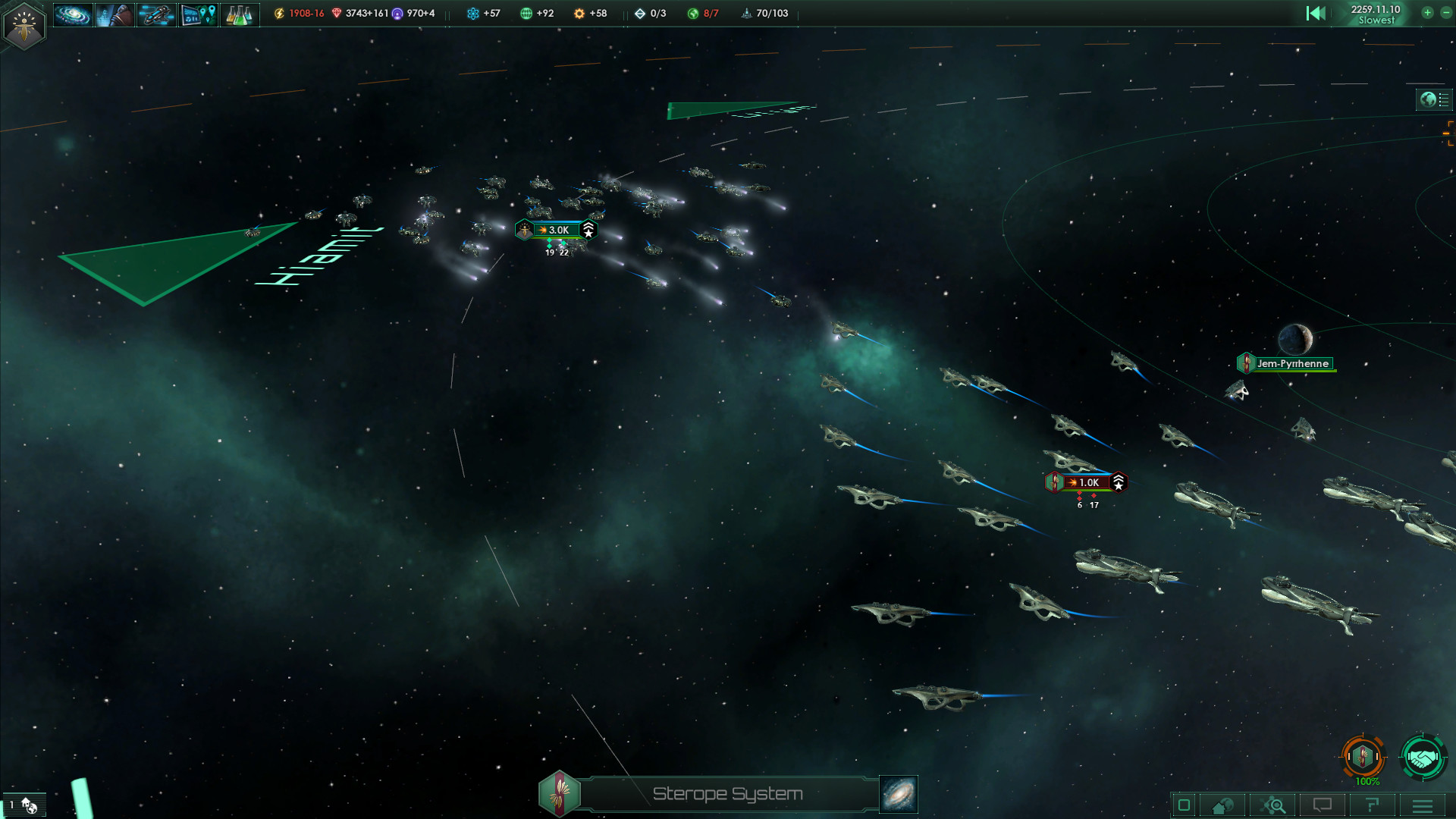Featuring deep strategic gameplay, a rich and enormously diverse selection of alien races and emergent storytelling, Stellaris has engaging challenging gameplay that rewards interstellar exploration as you traverse, discover, interact and learn more about the multitude of species you will encounter during your travels.
Etch your name across the cosmos by forging a galactic empire; colonizing remote planets and integrating alien civilizations. Will you expand through war alone or walk the path of diplomacy to achieve your goals?
Main Feature
- Deep & Varied Exploration.
- Enormous procedural galaxies, containing thousands of planets.
- Explore Anomalies with your heroic Scientist leaders.
- Infinitely varied races through customization and procedural generation.
- Advanced Diplomacy system worthy of a Grand Strategy Game.
- Ship Designer based on a vast array of technologies.
- Stunning space visuals.

by Atmaz
Hello!
I'm Gary Morris (or Atmaz) - Lead Game Designer on the Astral Planes DLC, from Abrakam Entertainment.
I've been playing video games my whole life. Some of my earliest memories are staying up way past my bedtime and grinding out hours and hours on strategy games on the Super Nintendo my older brother got for Christmas. I have specific memories of a particular game where I was cleaning up nuclear waste with my workers, tile by tile, and having a great time doing it. I didn't know it at the time, but I was enthralled by a type of game that would later become known as a "4X."
When I finally did get a computer, it was a Tandy 1000 HX. I still don't know what the HX stands for, or what the fascination is with adding X's onto things. On that machine, I quickly acquired a similar 4X game that was much older, but it captivated me just as much. Its lack of fancy graphics was not a problem for me, because I was given a very powerful new tool to play with: a keyboard. In my blissful ignorance, I never realized how much I had struggled with the SNES controller until I had the full complement of a keyboard and number pad (I don't remember there even being a mouse).
Fast forward about 25-30 years, and here we are today. Everyone has a mouse and keyboard, the 4X genre has exploded, and there are multiple great titles of this type to enjoy. One of the best ones, I say without prejudice, is Stellaris.
When we were asked by Paradox to start work with them on a new Stellaris expansion last year, my first thought was: What makes Stellaris fun? That's probably one of the hardest questions I've had to put serious thought to. It's easy to play the game and have fun - but why did I have fun? How do you measure Stellaris's fun?
There are more complicated answers to this, but the simplest place to start is that it takes you somewhere else. Just like when I was cleaning up nuclear waste with my workers all those years ago to save my cities, I get the same type of feeling when I survey a new system and find something new that might kill me. I like being somewhere else.
So, where is the farthest we can go? We're already in outer space in Stellaris - and really, do you need much more? The concept of space exploration is already so full of excitement and wonder. Stellaris captures this feeling so completely, it makes you wonder: What could possibly be next?
There are hints of what this could be already in-game: the mysteries of the Shroud and what it might contain, the unexplained appearance of the Unbidden and where they have come from. It's clear that there are other dimensions adjacent to our own, and we are teased with only tastes of them. This is the seed of thought from which Astral Planes was born.
Creative Director Jean-Michael Vilain and I talk about the inspiration for Astral Planes
What are Astral Rifts?
In each galaxy, there are points at which the boundaries of space and time are weaker than others. Once discovered, they will appear to you as Astral Scars. These Scars are not large enough to be explored, but they do leak through a significant amount of astral material which may be of some use to you.

An Astral Scar, still closed
Over time, it may happen that these Scars become unstable. After blossoming into a fully-blown Astral Rift, they are now open for you to explore. These Astral Rifts take us to the 'somewhere else' that exists beyond our known universe.

An open Astral Rift
However, you can't just plunge yourself into one of these things. The chaotic energies involved in these phenomena would literally tear your scientists into the base components of the universe. You'll need to find a way to slip them more carefully inside. This is where Rift Sphere technology comes in.

Rift Sphere
Achieving 'perfect smoothness' on any object is incredibly difficult - if not impossible. Apparently, it has been achieved here on earth on a very small scale with what is known as the "quantum stabilized atom mirror" earlier this century, but in most practical cases we cannot accomplish this. The James Webb Space telescope, for instance, has a reflective surface polished to an average roughness of only 20 nanometers. That's quite smooth, but we need to go even smoother to safely enter a Rift and have a vessel large enough to accompany a team of scientists. This will take some scientific effort on your part, but once complete you'll be ready to begin exploring other planes of existence.
Conceptually, the Rift Sphere device is loaded onto your science ships and shot like a bullet into the center of a Rift. It possesses basic propulsion capabilities, but for the most part is otherwise helpless on the other side. This is why a cable is tethered from its point of origin to allow for retrieval. This lifeline also serves as a means to send reports and other information from between universes.
Mid to late game exploration
One goal we had with Astral Planes was to provide more opportunities for exploration into the mid and late game. At a certain point, after all systems are explored and all Archeological Sites are exhausted, there naturally tends to not be much out there left to see.
Where Astral Rifts help out in this regard is that they are generally not present at map start. They will procedurally open over the course of the game. This means that even in a fully explored system, something new can still appear within your borders to take a look at.

The Dimensional Machine rift
Choose your own adventure
The significant difference between exploring a Rift and exploring an Archaeological Site is that your scientists are in the middle of a 'live' situation. You're not digging up the past and learning about what was, you're discovering something that currently is. This generally means they are often in much more danger, and decisions will need to be made on how to proceed based on the information you are given. On top of that, time can move much differently inside of a Rift, where years have passed on one side where only minutes have on the other end.
Most steps inside of an Astral Rift will provide a choice, and often they will have varying difficulty levels. You may choose to go the easier path to protect your scientists, or brave the danger and hope whatever it is they are trying is a success. A heavy "Risk vs Reward" concept is present in these explorations. There are multiple results that can be achieved from exploring each Rift, and we've added over 30 of them. Inside of many of those Rifts are brand new Relics you can find - provided you make the right choices, and provided your Scientists survive those choices.
There are not just Relics that you can find, however. Nearly every Rift contains some sort of possible unique reward, from new Faction Modifiers, to Planetary Decisions, to even recruitable Leaders. You're entering other places far from your own that have any number of exotic things to discover.
There are even more things, however, that you bring back with you from inside these Rifts - and we call those Astral Threads.

Astral Threads
Let's talk about what you can do with those in the next post.
From behalf of all of our team, thank you for reading this, and thanks to Paradox for giving us this amazing opportunity to create something we think is really cool.
See you soon!
Minimum Setup
- OS: Ubuntu 20.04 x64
- Processor: Intel iCore i3-530 or AMD FX-6350Memory: 4 GB RAM
- Memory: 4 GB RAM
- Graphics: Nvidia GeForce GTX 460 or AMD ATI Radeon HD 5870 (1GB VRAM). or AMD Radeon RX Vega 11 or Intel HD Graphics 4600Network: Broadband Internet connection
- Storage: 12 GB available space
Recommended Setup
- OS: Ubuntu 20.04 x64
- Processor: Intel iCore i5-3570K or AMD Ryzen 5 2400GMemory: 4 GB RAM
- Graphics: Nvidia GeForce GTX 560 Ti (1GB VRAM) or AMD Radeon R7 370 (2 GB VRAM)Network: Broadband Internet connection
- Storage: 12 GB available space
[ 6381 ]
[ 5876 ]
[ 1265 ]
[ 2018 ]
[ 986 ]









































